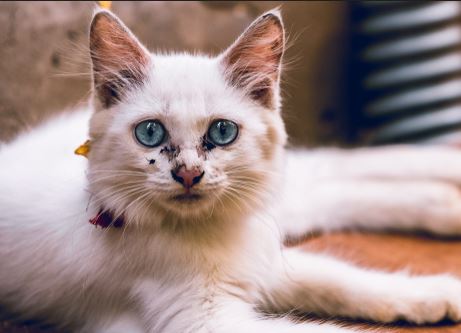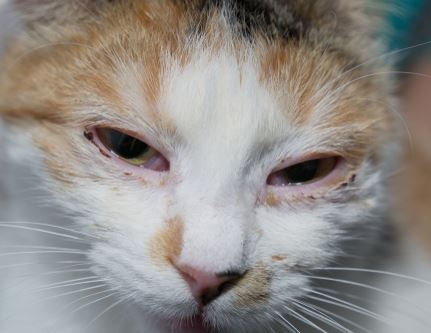In practice, new cat owners occasionally called me to express concern when they noticed black gunk around their furbaby’s eyes or nose. I would explain that cats may have normal discharge from their eyes and nose for various reasons, but sometimes the discharge indicates an underlying condition. In this article, we’ll discuss the reasons cats can have black gunk around their nose and eyes, what to do about it, and how to clean the gunk around your cat’s face.
What does a black crust around my cat’s eyes and nose look like?
Black crust from your cat’s eyes or nose may be minor as seen in the corner of this kitty’s eye:

This matter is often normal and forms in response to environmental allergens or irritants like dust. This stray kitten has more pronounced black gunk which may be a buildup of normal secretions or an indication of an underlying infection or condition:

When cats have heavy gunk around the eyes/nose it can indicate they have a bacterial or viral respiratory infection, as is the case with this cat with Feline Panleukopenia.

Can black crust be a sign of a more serious medical condition?
When you occasionally see black crust on your cat’s face, don’t panic. It’s usually not a sign of a serious medical condition. It can be a normal response to dust, pollen, or another irritant. Additionally, certain breeds like Himalayans and Persians tend to produce more tears and eye matter because of their flat noses and large eyes.
However, if your cat’s black gunk persists or occurs with other symptoms, it may indicate an underlying condition. You should take your kitty to the vet if:
- Watery eyes and black gunk that lasts more than a few days
- The tears and gunk are more than the normal amount for your cat
- Your cat’s eyes are swollen
- There’s a thick or goey discharge around the nose and eyes
- Your cat’s eyes are red or look sore
- Your cat is pawing at or rubbing her face
- Your cat is squinting or blinking like she has something in her eyes
Home care: tips to clean around your cat’s eyes and nose

If your cat has black gunk or crust formation around the eyes and nose, clean the area every day to remove buildup.
- Soak a clean cotton ball in warm water and wring out excess moisture.
- Gently wipe around the outside of the nose and eyes to soften and remove the crusts.
- Do not use over-the-counter washes or eye drops without your veterinarian’s approval.
- Do not reach inside the nostril with a cotton swab or ball.
What are the possible causes of black crust around a cat’s eyes and nose?
There are various reasons you may see black crust around your kitty’s eyes and nose. Some are the result of normal tearing and eye matter build-up, while others are due to a serious condition.
1. Tear stains

If cats produce extra tears or they have a blocked nasolacrimal duct, the excess moisture around the eyes spills onto the fur and dries. When the air oxidizes the secretions, they turn dark and may appear black. When your kitty develops tear stains, clean the gunk from her face. If the symptoms continue talk to your veterinarian.
2. Environmental irritants
Cigarette smoke, dust, and other pollutants in the air can build up around your cat’s eyes and nose. The particles mix with normal mucus discharge (boogers) causing black gunk. When you see mild black gunk around the face with no other symptoms, no worries. Clean the material away to prevent infections and monitor your kitty to make sure the gunk doesn’t recur.
3. Allergies
Just like us, cats can develop sensitivities to certain foods, dust, pollen, or other substances. If your furbaby reacts to an allergen, her eyes may tear to flush out irritants. When the secretions dry out causing a black crust. Cats with allergies that affect the upper respiratory system may also exhibit:
- Coughing
- Sniffling
- Wheezing
If your cat shows signs of allergies, you can try to minimize exposure. Consult with your veterinarian about allergy testing or food elimination trials to pinpoint the trigger substance. When food is involved, switch your kitty to a hypoallergenic formula featuring a novel protein source. For severe allergies, your veterinarian may prescribe corticosteroids.
4. Upper respiratory infections
Cats can develop upper respiratory infections from bacteria or viruses. Some respiratory infections that can cause black gunk include feline herpes virus, feline calicivirus, and chlamydiosis. When your kitty has an infection, he may have the following signs.
- Watery eyes
- Increased mucus production that can produce a black crust
- Puffy eyes

- Sneezing
- Coughing
- Loss of appetite
- Lethargy
If your cat shows signs of a respiratory infection, isolate her from other kitties in the house to prevent passing it on. You can care for mild cases at home. If your furbaby has a purulent discharge or severe symptoms, plan a visit to your veterinarian. While you’re waiting for your appointment, you can try applying cool used bags of chamomile tea to the area to soothe irritation.
The veterinarian will conduct a physical examination and run diagnostic tests to determine the cause of your kitty’s ailment. Treatment may include eye ointments, antibiotics, and decongestants.
5. Dry eye
Cats suffering from dry eyes, also known as keratoconjunctivitis sicca(KCS), do not produce enough tears to lubricate and protect the eyes. Felines with dry eye syndrome often have a thick discharge that can cause a black crust around the eyes. Signs include
- Red, irritated eyes
- Squinting
- Repetitive blinking or holding the eyes shut
- Thick, mucoid discharge
- Corneal ulcers
- Blindness
Because KCS can lead to blindness and other serious conditions, you should schedule an examination with your veterinarian. He can diagnose dry eye with a Schirmer tear test or other diagnostic tests. Treatment for dry eye involves tear replacement eye drops. The doctor may also prescribe topical antibiotics and anti-inflammatory medications if needed.
6. Pink eye/conjunctivitis
Pink eye is a descriptive term for conjunctivitis. With this condition, the lining of the eye and inner eyelid becomes inflamed. Symptoms of conjunctivitis include:
- Eye discharge that’s yellow, light green, or clear
- Crusting around the eyes
- Inflammation around the eyes
- Redness and swelling around the eye
- Light sensitivity
- Rubbing or pawing at the eyes
Because pink eye is often caused by bacteria or viruses you may also notice signs of an upper respiratory infection. Cats with conjunctivitis should be seen by a veterinarian. In the meantime, apply warm compresses to your cat’s eyes to help soothe irritation and reduce inflammation.
The doctor can examine your kitty and determine the underlying condition. Treatment may include:
- Antibiotic eye drops
- Antiinflammatory medications
- Pain medications
- E-collar to prevent rubbing or scratching the eye
7. Corneal disorder
The eye will produce extra tears when a cat’s cornea becomes scratched, ulcerated, or inflamed. Other symptoms include:
- Cloudiness in the eye

- Frequent blinking
- Excessive eye discharge that may cause crusting
Corneal disorders are very painful for cats. Don’t delay contacting your veterinarian to schedule an appointment. Once the vet identifies the abrasion, he can prescribe the appropriate medications, such as:
- Antibiotic drops or ointment
- Topical atropine to treat pain and spasms
- Suturing the third eyelid over the injury for a few days
- Surgical debridement of dead cells at the edge of the ulcer if needed
8. Uveitis
Uveitis is inflammation of the middle layer, uvea, of the eye. Usually caused by trauma or immune-mediated disorders, this disease is very painful. Signs include:
- Squinting
- Blinking spasmodically
- Either pawing at the eye or avoiding any contact
- Watery or pus discharge from the eye
- Cloudiness in the eye
Uveitis is a treatable condition, but it can lead to retinal detachment or blindness if you don’t seek appropriate care. If your cat shows signs of uveitis, schedule an examination with your veterinarian. The doctor can perform an ophthalmic examination and measure intraocular pressure to diagnose the disease. The main treatment for uveitis is topical corticosteroids such as dexamethasone or non-steroidal anti-inflammatory drops such as flurbiprofen.
9. Eye growths
Tumors on the eyelid or conjunctiva in cats are usually malignant. When they appear, they irritate the surface of the cornea and cause excessive tearing that can lead to the formation of black gunk. They may present as lumps and bumps or slow-healing sores.
If you notice any unusual growths or sores around the eye, contact your veterinarian immediately. The doctor will examine the lesion and may take a biopsy to identify the type of tumor. Treatment varies depending on the type, location, and size of the tumor but may include:
- Surgical removal
- Cryotherapy
- Radiation therapy
Frequently asked questions
How often should I clean the area around my cat’s eyes and nose?
When your cat has tearing, eye discharge, or black crusting, you should clean around the eyes and nose at least once a day to prevent debris buildup.
Are there any home remedies I can try to prevent boogers?
Some things you can do at home to help prevent eye and nose boogers include:
- Invest in an air purifier to minimize dust particles
- Groom your cat regularly to remove dirt and loose hair
You may also try the following home remedies to help loosen debris around your cat’s nose and eyes.
- Sterile saline solution
- Chamomile tea bags
- A drop or two of coconut oil
Is this a serious situation worth veterinary or emergency treatment?
Black gunk or crusting around the eyes is usually not an emergency, but it may point to an underlying condition. You should schedule an appointment with your veterinarian if you observe:
- Sudden, excessive tearing or nasal discharge
- Gunk or crusting doesn’t clear up in a few days
- You find fresh blood on your swab when cleaning around the eyes/nose
- There are other symptoms of a disease

